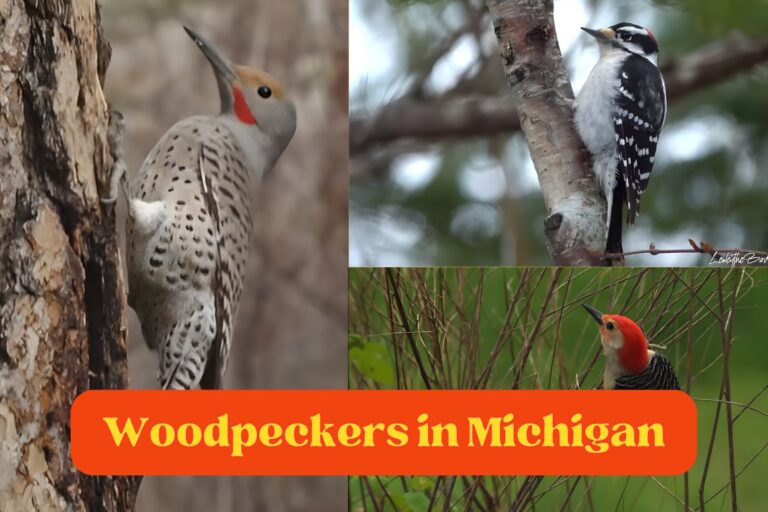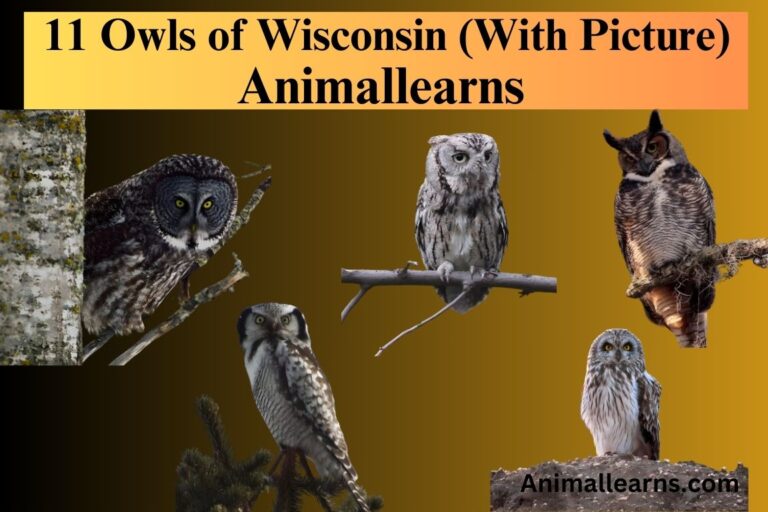Woodpeckers in Ohio (Types, Pictures, and Facts)

Woodpeckers in Ohio are a diverse and captivating group of birds, attracting birdwatchers from near and far to observe their unique behaviors. As the Buckeye State, Ohio offers a diverse range of habitats for bird lovers, making it a great birding destination all year round.
In Ohio’s woodlands, you can find woodpeckers, a family of Picidae, and exotic species such as toucans and barbets. Its landscape ranges from open fields to lush wetlands, making it a birding paradise. In addition to their strong legs, zygodactyl toes, and skull structure, they are attracted to dead trees for insects.
There are seven different species of woodpeckers in Ohio, of which five are permanent residents. Woodpeckers are known for their rhythmic tree-tapping. Discover their beauty and how to attract them to get an up-close birding experience in Ohio.
Woodpeckers in Ohio, with their black, purple, and white plumage, contribute to the avian diversity of white birds in the state. Woodpeckers add charm to hikes and backyards in Ohio. Discover their features, size, and where to find them.
Woodpeckers in Ohio
Contents
Ohio is home to a diverse range of woodpecker species, making it a popular destination for bird enthusiasts and wildlife watchers. The state boasts a variety of woodpecker types, from common to rare, and identifying them can be a rewarding experience for birdwatchers.
In Ohio, you can find woodpeckers like the Downy woodpecker, the red-headed woodpecker, and the Pileated woodpecker. Understanding the different woodpecker species in Ohio is essential for appreciating the state’s rich avian biodiversity.
Birdwatchers and nature enthusiasts often seek out these woodpeckers in Ohio’s diverse habitats for a memorable avian experience.
7 Types of Woodpeckers in Ohio
Downy Woodpecker
Hairy Woodpecker
Red-bellied Woodpecker
Northern Flicker
Pileated Woodpecker
Yellow-bellied Sapsucker
Red-Headed Woodpecker
Downy Woodpecker

| Attribute | Information |
|---|---|
| Scientific Name | Picoides pubescens |
| Size | Small |
| Color | Black and white |
| Weight | 0.7 – 1.0 oz |
| Length | 5.5 – 6.7 inches |
| Wingspan | 9.8 – 11.8 inches |
| Location | Common across North America |
A common sight in Ohio is the Downy Woodpecker, North America’s smallest and most abundant woodpecker. There is a red patch on the head of males, and they have pied black and white plumage that includes a black head with two white bars and black wings with white spots.
They primarily feed on insects like ants, caterpillars, and beetles, making them an integral part of pest control. They live in deciduous forests, open woodlands, and woodland edges.
With their small size, the Downy Woodpecker can reach small food items easily, making suet, peanuts, mixed seeds, and black sunflower seeds an excellent way to attract him.
These adaptable birds might surprise you by sipping nectar from hummingbird feeders, but they’re not only found in feeders. You can also see them drilling trees for insect larvae or eating berries and acorns.
Hairy Woodpecker
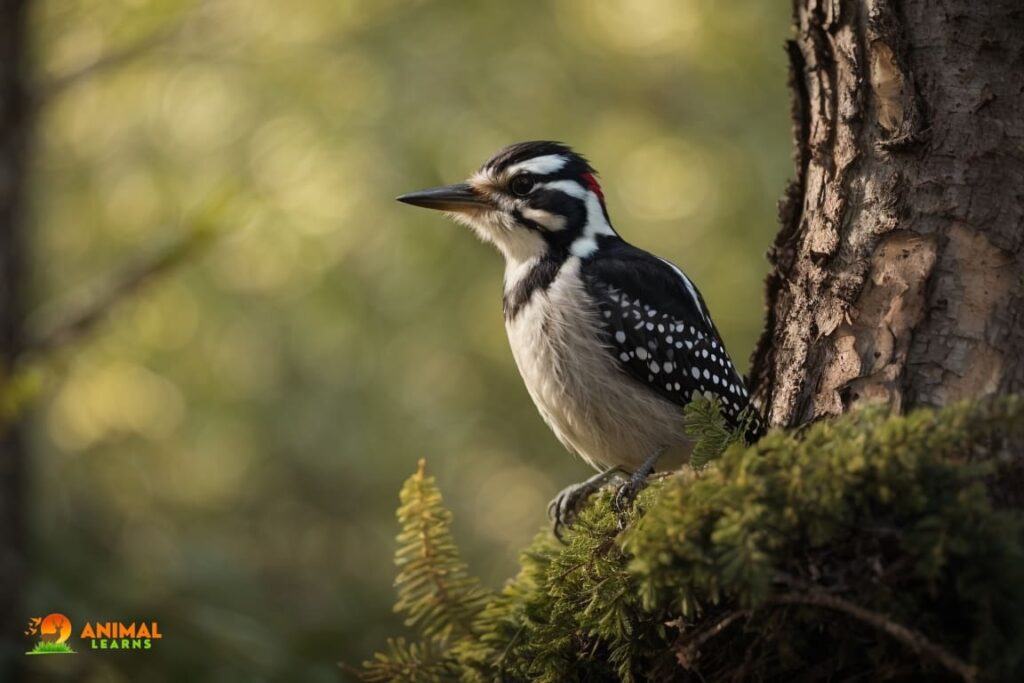
| Attribute | Information |
|---|---|
| Scientific Name | Picoides villosus |
| Size | Medium |
| Color | Black and white |
| Weight | 1.4 – 3.4 oz |
| Length | 7.1 – 10.2 inches |
| Wingspan | 13.0 – 16.1 inches |
| Location | Widespread in North America |
When looking at tail feathers, you can tell the difference between a hairy woodpecker and a downy woodpecker. Downy woodpeckers have spotted tail feathers, while hairy woodpeckers have plain white tail feathers.
A gray-headed hairy woodpecker in Ohio also makes rattling whinny calls and has white underparts, facial stripes, and wing spots. The northerners are larger and have white underparts, while Ohio’s hairs have white underparts, facial stripes, and white wing spots.
Their nesting sites are threatened by forest fragmentation and competition with starlings for nesting sites. Hairy woodpeckers eat insects and pests, as well as ants, bees, spiders, and some plant foods.
It is difficult to tell the difference between a hairy woodpecker and a downy woodpecker in Ohio. Both species share the same habitat and diet, but it is more difficult for hairy woodpeckers to visit suet feeders on a regular basis.
Red-bellied Woodpecker
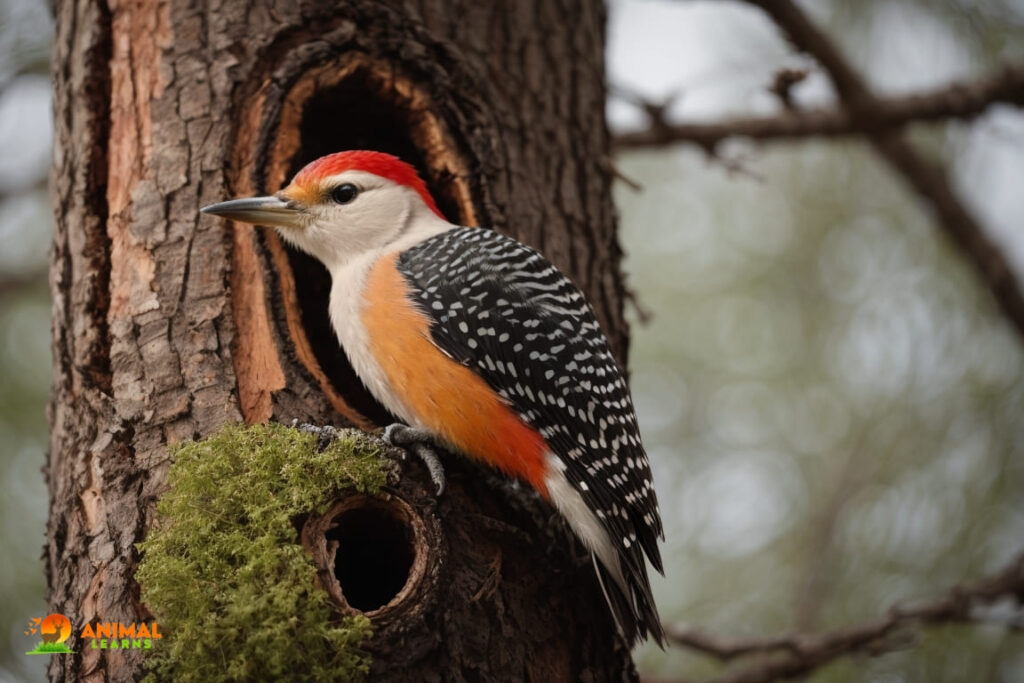
| Attribute | Information |
|---|---|
| Scientific Name | Melanerpes carolinus |
| Size | Medium |
| Color | Black and white with red cap |
| Weight | 2.0 – 3.2 oz |
| Length | 9.4 – 9.8 inches |
| Wingspan | 13.0 – 16.5 inches |
| Location | Eastern and southeastern United States |
It has striking red plumage that includes black and white wing bars, as well as a subdued red belly. Both males and females have bright red caps and red patches above their bills, which distinguish them from red-headed woodpeckers.
Its vocal habits make it a common sight in Ohio’s woodlands and forests. The medium-sized woodpecker nests in cavities they excavate, providing homes for other cavity-nesting birds. The woodpeckers have an adaptable diet, eating arthropods, seeds, and nuts.
Look for their distinct black and white barred wings and the red mohawk-like patch on their neck to identify these year-round residents of Ohio. They’re slightly larger than Downy Woodpeckers and similar in size to Hairy Woodpeckers.
In the eastern U.S., they can be found at feeders eating suet and nuts. Although their name suggests a red belly, their red streak and heavily barred wings are prominent.
A red-bellied woodpecker has an impressive tongue, reaching up to two inches in length. It is well known for its barbed end and sticky saliva for effective insect hunting. With a wingspan of 15 to 18 inches, these captivating birds thrive in Ohio’s woodlands and forests, from Florida to Canada.
Northern Flicker

| Attribute | Information |
|---|---|
| Scientific Name | Colaptes auratus |
| Size | Medium |
| Color | Brown with spots |
| Weight | 3.9 – 5.6 oz |
| Length | 11.0 – 12.2 inches |
| Wingspan | 16.5 – 20.1 inches |
| Location | Widespread in North America |
Northern flickers are distinguished by their colorful appearance, with brown plumage adorned with black bars, a beige underbelly covered in black spots, and a crescent shape on the breast.
A bright yellow underwing (red in western birds) and a charming “mustache” extend from their bills when they are in flight. Males sport a striking “mustache” with red stripes.
They use their long, sticky tongues to peck and flick for insects, unlike most woodpeckers. Some of their nest holes are created by other birds; they’re commonly found in woodlands, wetlands, and open fields in Ohio. They’re year-round residents, but they’re most abundant during migration.
These birds complement Ohio’s birdlife with their bright plumage and unique behavior. They nest in old, decaying trees and are well-known for their foraging skills. Woodpeckers in Ohio, including the Northern Flicker, contribute to the state’s rich birdlife, with their unique behaviors and characteristics.
Generally speaking, northern flickers are classified into two types, the yellow-shafted and the red-shafted groups. They are usually brown with black bars, but they vary in size and color.
Yellow-shafted flickers have golden underwings, while western red-shafted flickers have red underwings. Their wingspan is as long as 21.5 inches and they measure 11 to 14 inches in length.
Pileated Woodpecker
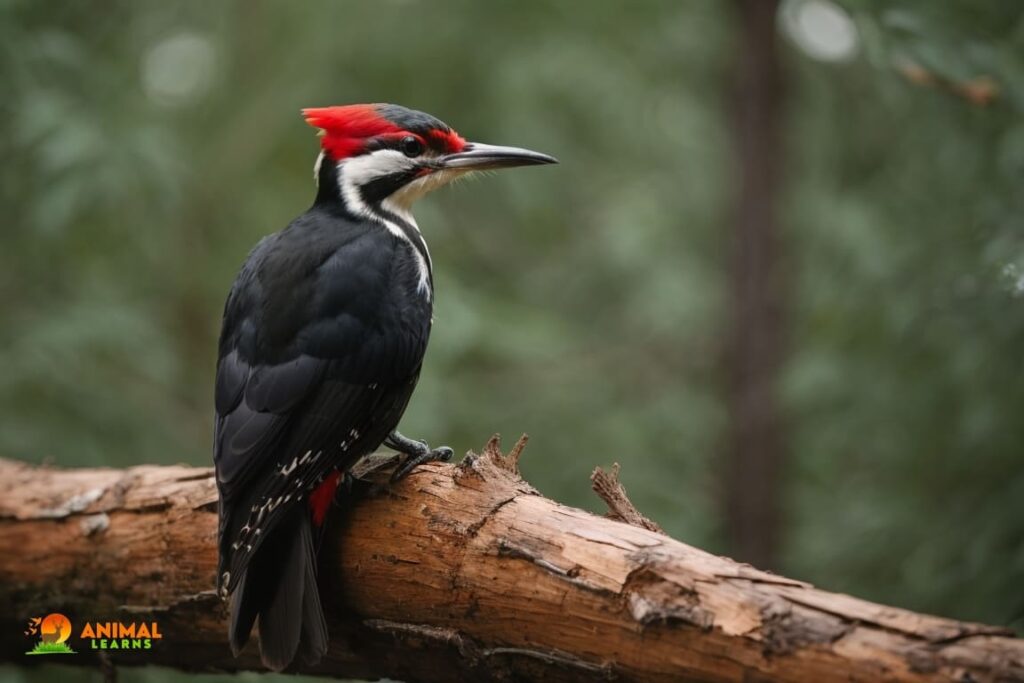
| Attribute | Information |
|---|---|
| Scientific Name | Dryocopus pileatus |
| Size | Large |
| Color | Black with red crest |
| Weight | 8.8 – 12.3 oz |
| Length | 15.8 – 19.3 inches |
| Wingspan | 26.0 – 29.5 inches |
| Location | Throughout North America |
The Pileated Woodpecker, one of the largest woodpeckers in Ohio, is known for its striking appearance with its bold red crest and black plumage. Its diet includes carpenter ants, insects, and berries, some of which are toxic to other creatures. These impressive birds prefer mature forests, hardwoods, and parks with large trees in Ohio.
In Ohio, the pileated woodpeckers live throughout the year. They have a unique call that resembles monkey laughter, which sets them apart from other woodpeckers.
Despite nesting competition with other species like European starlings and bluebirds, these birds thrive in wooded habitats, including near human dwellings.
Install nest boxes or maintain dead and dying trees to attract pileated woodpeckers to your property. The species is widespread in Ohio, particularly in the southern region, where old, decaying trees are abundant. They may occasionally visit feeders, but their large size and elusive nature prevent them from being frequent backyard visitors.
Yellow-bellied Sapsucker

| Attribute | Information |
|---|---|
| Scientific Name | Sphyrapicus varius |
| Size | Small to medium |
| Color | Black, white, and red |
| Weight | 1.4 – 1.8 oz |
| Length | 7.1 – 8.7 inches |
| Wingspan | 13.0 – 15.8 inches |
| Location | Northern North America and Central America |
Among the various woodpeckers in Ohio, the Yellow-bellied Sapsucker stands out as an interesting species with its unique feeding habits and colorful plumage.
Having a yellow-tinted belly, black upperparts with white spots, and a bright red forehead, the yellow-bellied sapsucker is a distinctive medium-sized woodpecker. Spring and fall migrants, these birds make neat rows of sap wells along tree trunks because of their sap-sucking habits.
Their long tongues use sap and insects to feed on tree branches, and they rarely visit bird feeders. However, they do occasionally visit suet feeders.
It is uncommon for them to visit feeders, but they occasionally forage on branches, using their specialized tongues to forage insects and sap.
It has a yellow-washed plumage and bright red head stripes that distinguish it from the downy woodpeckers in Ohio. Males display vibrant red throats despite their initial resemblances to downy woodpeckers. They primarily eat tree sap, which they drill into with characteristic sap holes, to obtain food.
Throughout Ohio and Canada, these spectacular woodpeckers offer unique traits and behaviors to the state’s birdlife, making them an intriguing sight for wildlife lovers.
Red-Headed Woodpecker

| Attribute | Information |
|---|---|
| Scientific Name | Colaptes auratus cafer |
| Size | Medium |
| Color | Brown with spots and red shafts |
| Weight | 3.9 – 5.6 oz |
| Length | 11.0 – 12.2 inches |
| Wingspan | 16.5 – 20.1 inches |
| Location | Western North America |
A striking medium-sized bird with black, white, and red plumage, the red-headed woodpecker is closely related to the red-bellied woodpecker. Both males and females share the same plumage, which consists of black backs, white underbelly, and a distinctive red head and neck. Juveniles begin with gray heads, which eventually turn to red as they mature.
In winter, they reside in deciduous, coniferous, and mixed forests. They prefer breeding in deciduous woodlands, farmlands, orchards, and forest edges. The red-headed woodpecker tends to forage near water bodies, especially dead trees. There is no sexual dimorphism, so both males and females look the same.
In addition to storing food in caches, they camouflage them with bark or wood, making them less common backyard visitors than other woodpecker species. They tend to visit suet feeders less frequently than other woodpecker species.
Woodpeckers of this species eat insects, seeds, and berries, and they are skilled flycatchers. They are becoming increasingly rare as their population declines in some areas. Despite being found all year round in Ohio, they may be less common outside of winter in the southeastern region.
A stunning addition to Ohio’s birdlife, the red-headed woodpecker has a unique foraging habit that sets it apart.
Interesting Facts
- Birdwatchers will find a variety of woodpecker species in Ohio.
- Black and white woodpeckers in Ohio have bright accents on their heads.
- The Downy Woodpecker is the smallest woodpecker in Ohio, while the Pileated Woodpecker is the largest.
- Woodpeckers and other forest and wetland species thrive in the woodlands and forests of Ohio.
- Woodpeckers communicate and locate food by drumming and pecking.
- For shelter and protection, they excavate nesting cavities in trees.
- They eat insects, fruits, nuts, seeds, and nuts.
- Some woodpecker species face habitat threats, prompting conservation initiatives.
- Many woodpeckers stay in Ohio throughout the year, enhancing birdwatching opportunities.
- Bird lovers can lure woodpeckers to their yards with suet, nuts, and suitable feeders.
Protecting Ohio’s Woodpeckers
Woodpeckers are not only fascinating birds to observe, but they also play crucial roles in their ecosystems. In Ohio, woodpeckers are protected under state and federal laws, making it illegal to harm or kill them. The legal protections for Woodpeckers in Ohio ensure their survival and contribute to the overall health of Ohio’s ecosystems.
If you’re wondering about the largest woodpecker species in Ohio, the Pileated woodpecker takes that title, and these large woodpeckers are a testament to the state’s commitment to preserving its avian residents.
FAQs
Are there woodpeckers in Ohio?
Yes, Ohio is home to a variety of woodpecker species.
What types of woodpeckers can be found in Ohio?
Ohio hosts several woodpecker species, including the Downy woodpecker, red-headed woodpecker, and Pileated woodpecker.
Are woodpeckers protected in Ohio?
Yes, woodpeckers in Ohio are protected under state and federal laws, making it illegal to harm or kill them.
What is the largest woodpecker species in Ohio?
The largest woodpecker species in Ohio is the Pileated woodpecker.
Are there any rare woodpeckers in Ohio?
Yes, Ohio is home to some rare woodpecker species, adding to the state’s avian diversity.








